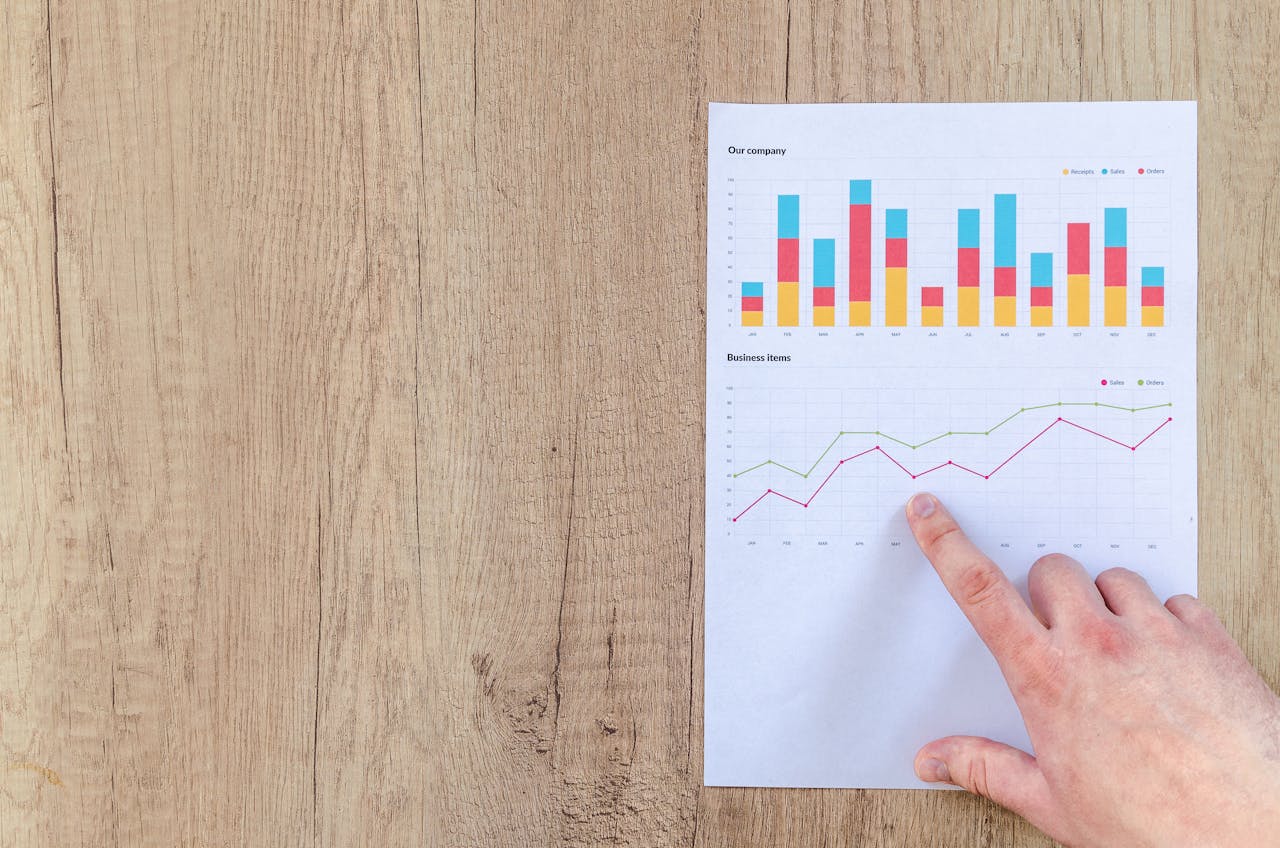

For many small businesses, success is often measured by one metric – profit! However, focusing on profit alone can hinder your business’ direction. Cash might be tightening, customers might be churning, or costs might be creeping up… and yet, the bottom line will look okay – for now!
That’s where Key Performance Indicators (KPIs) come in. KPIs help you to measure progress, efficiency, and financial health. By tracking the right KPIs, you gain a clear view of what’s really driving your business, and where to focus your energy next.
In this guide, we’ll explore the 10 most valuable KPIs every small business should track, and show you how to model each one easily in Brixx, so you can plan smarter and make confident business decisions.
What are KPIs and why do they matter for small businesses?
Every business tracks numbers, but not every number is a KPI (Key Performance Indicator). A KPI is a specific metric that measures how well your business is achieving its goals.
For example, if your goal is to improve profitability, your gross profit margin or customer acquisition cost might be your key indicators. If you’re focused on growth, revenue trends or cash flow health could be more important. KPIs give those goals a measurable target, helping you see if you’re moving in the right direction, or if you need to adjust course!
Unlike general metrics, which are often not actionable, KPIs are tied directly to performance. They tell you whether your decisions are paying off and provide early signals when something’s not working.
How does Brixx help you track KPIs automatically?
In Brixx, every part of your financial model connects automatically to your KPIs. You can view margins, growth rates, or cash positions without manual calculations or spreadsheet formulas. Each time you update your forecast, your KPIs update too, giving you a live picture of your business performance.
It’s a simple, visual way to stay focused on what truly matters, which are the numbers that drive your success.
How to choose the right KPIs for your business
There are so many metrics in the world of business, and it’s easy to get lost in the numbers and acronyms. The key recommendation is to focus on a few KPIs that actually move the needle for your business. Think of KPIs as your dashboard. If there are too many dials, it becomes impossible to see what’s really going on.
Here are a few simple questions to help you pick the right ones:
- Is it relevant? Does this metric tie directly to your business goals? If your priority is growing revenue, focus on things like conversion rates or sales growth, and not just website visits.
- Is it measurable? You should be able to track it consistently with real data, not gut feeling.
- Does it have impact? The best KPIs reveal insights that drive action. If changing this number wouldn’t make a difference to your results, it’s probably not a key indicator.
- Is it simple? Everyone on your team should understand what the KPI means and why it matters.
Every business is different, and your KPIs should reflect that. A retail company might focus on inventory turnover and average order value, while a SaaS business tracks monthly recurring revenue and churn rate.
That’s where Brixx comes in handy. Its industry-specific templates automatically highlight the KPIs most relevant to your business type. Whether you’re running an e-commerce store or a local agency, Brixx adjusts your model and reports to fit what matters most to you.

What are the top 10 KPIs every small business should track?
Every business is different, but some KPIs are so useful that almost every business should keep an eye on them. These metrics give you a clear picture of your financial health and long-term sustainability – and best of all, they’re easy to model in Brixx!
Here are ten of the most important KPIs:
1. Revenue growth
Your revenue growth rate shows how quickly your income is increasing over time. It’s a simple but powerful way to track momentum and spot early trends, whether positive or negative.
- In Brixx: You can instantly see your revenue growth across months or years, helping you forecast future performance and test new pricing or sales strategies.
2. Gross profit margin
Gross profit margin tells you how efficiently you’re producing and selling your products or services. It shows the percentage of sales left after covering direct costs.
- In Brixx: Margins update automatically when you tweak sales or cost assumptions, helping you see how even small changes affect profitability.
3. Net profit margin
Net profit margin is your bottom line. This measures how much profit remains after all expenses are paid.
- In Brixx: Because your forecast connects everything, you’ll always see a clear picture of your true profitability.
4. Operating cash flow
Cash flow is the lifeblood of any small business. Even profitable companies can run into trouble if cash isn’t coming in at the right time.
- In Brixx: The 3-way forecast automatically updates your cash position based on every inflow and outflow, so you can spot gaps before they happen.
5. Customer acquisition cost (CAC)
How much does it cost to win a new customer? Customer acquisition cost helps you measure the efficiency of your sales and marketing spend.
- In Brixx: Model your marketing costs and new customer projections to see how CAC changes as your campaigns scale.
6. Customer lifetime value (CLV)
Customer lifetime value shows the total revenue you can expect from a single customer throughout their relationship with your business. It’s essential for knowing how much you can afford to spend on acquisition.
- In Brixx: Link recurring revenue and retention rates to get a clear, forecasted picture of customer value.
7. Break-even point
Your break-even point tells you how much you need to sell to cover all your costs. Beyond that point, every sale is profit.
- In Brixx: You can instantly calculate break-even by comparing fixed and variable costs to your sales forecast.
8. Accounts receivable days
Accounts receivable tracks how long it takes for customers to pay you. Slow payments can choke cash flow.
- In Brixx: Adjust your payment terms in the model to see how delayed receipts impact your bank balance and runway.
9. Burn rate
For startups, burn rate is the rate at which you’re spending your available cash. It tells you how long your current funds will last.
- In Brixx: The platform automatically calculates burn rate and runway, helping you plan when to raise new funding.
10. Current ratio
Current ratio measures liquidity. This is your ability to pay short-term obligations. It’s a quick way to gauge financial stability.
- In Brixx: With assets and liabilities already connected in your forecast, you can monitor your ratio in real time as your model evolves.
Tracking these KPIs regularly gives you the insights you need to make confident, data-driven decisions. And with Brixx, you don’t have to wrestle with spreadsheets or formulas; it’s all built in, visualised, and ready to share.

How to model KPIs in Brixx
Once you’ve decided which KPIs matter the most to your business, the next step is bringing them to life in your financial model. That’s where Brixx shines. Brixx can connect every part of your business, so your KPIs are automatically calculated and always up to date.
Here’s how to start tracking and analysing your KPIs in Brixx:
1. Set up your key revenue streams
Begin by modelling how your business earns money. Add your main income components – such as product sales or subscriptions – and forecast how they’ll grow over time. Brixx automatically calculates revenue growth, gross margin, and net profit as you adjust your assumptions.
2. Add your costs
Next, enter your direct costs (like materials or labour) and overheads (like rent and salaries). This builds out your profit and loss statement and feeds straight into KPIs such as gross margin, net profit margin, and break-even point.
3. Connect your timing
Set realistic payment terms for both income and expenses. This ensures your cash flow forecast reflects when money actually moves, and not just when it’s earned or owed.
4. Factor in people and resources
If your business relies on staff, vehicles, or equipment, model them too. These components affect multiple KPIs, including burn rate, current ratio, and net profit margin.
5. Review your dashboard
Brixx visualises your financial data automatically. It will show you KPI trends, cash runway, and performance ratios in clear, interactive charts. You can drill into any figure to understand what’s driving the change.
6. Test different scenarios
Want to see how a business decision could affect your KPIs? With scenario planning in Brixx, you can compare different versions of your forecast side by side, without needing to juggle multiple spreadsheets.
Get started with our forecasting software so that you can plan your business' future
Track and manage your KPIs in Brixx
Turn your KPIs into action with Brixx
As we have demonstrated, tracking KPIs isn’t just about reporting on numbers. It’s really about understanding what those numbers mean for your business’ future. The right metrics will show you when things are off course, and they’ll provide you with clear evidence when your strategies are working.
With Brixx, you can go beyond static reporting. Instead of just seeing how your business has performed, you can model what happens next. Whether that might be hiring new staff, launching a new product, or simply managing cash flow through a quiet season. Every KPI connects to a living, breathing financial model that updates automatically as your plans evolve.
If you’re ready to move past spreadsheets and start making data-driven decisions with confidence, give Brixx a try.
Start your free trial today and see how easy it is to model your KPIs – and your business’s future – in Brixx.












